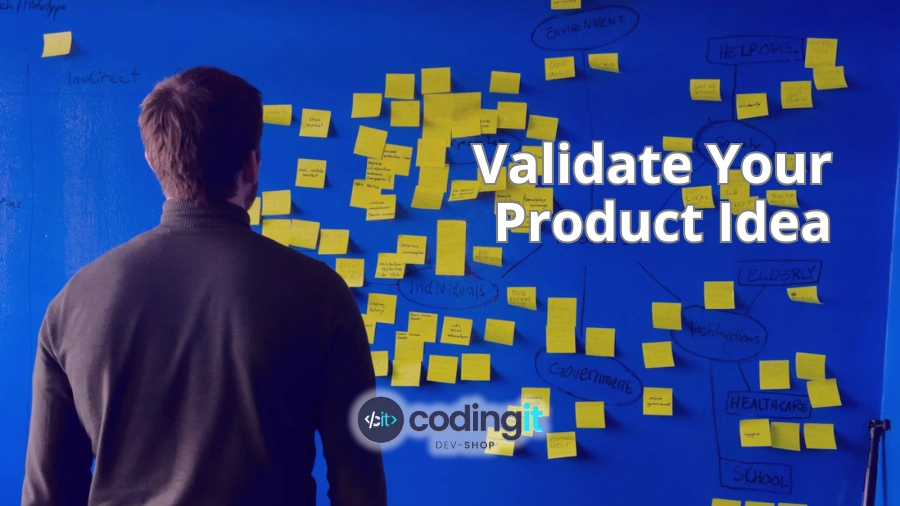As a non-technical founder, coming up with a product idea is a very exciting experience, but figuring out whether that idea is worth pursuing can be daunting. You’re probably wondering if it’s worth chasing it or if you’re about to spend the next few months (or longer!) running after something that might not work.
This is especially tricky if you’re someone who isn’t sure when to start building, how to test their idea, or even where to begin. No one wants to spend tons of time and money on a product that disappears into thin air.
That’s where idea validation comes in. It’s basically your product’s “trial run” to see if it’s solving a real problem and whether people are actually interested. Fortunately, you don’t need to know how to code or build anything fancy to figure this part out these days. In fact, the idea here is to keep things simple—think of it like testing the waters before jumping in headfirst.
Today, we’ll walk you through the steps you need to understand to see if your idea is worth pursuing, track early interest, and decide when it’s time to build. So, let’s dive into how to validate a product idea and start building something people actually want.

Start with the Problem, Not the Solution
One of the biggest traps, when you have a shiny new product idea, is getting way too attached to your solution. You know, that brilliant thing you’ve dreamt up that’s going to change the world. But here’s a little secret: the solution doesn’t really matter if you’re not solving a real, actual problem.
I don’t want to sound rude, but no one’s going to care about your product unless it makes their lives easier in some way. So, before you get too excited about your idea, you need to dig into the problem first. What’s the issue you’re solving? Does anyone really need this?
Spend some time talking to people who might benefit from your idea. Ask them how they’re currently dealing with the problem you think you’re solving. Their answers might actually surprise you! They might already have a workaround or, worse, they might not even see it as a problem.
But this is all good stuff. You want this information upfront. It’s about learning what your audience really needs and then shaping your idea around that. By focusing on the problem first, you’re setting yourself up for success and making sure your product isn’t just something you love, but something your customers will love too.
Define Your Audience
Let’s get one thing straight: your product is NOT going to be for everyone. And that’s totally okay. It’s a good thing! Trying to build something that appeals to everyone is like trying to please every single person at a party. Trust me, it’s exhausting, and no one ends up having a good time.
One way to focus on a specific group is by creating what’s called a customer persona. Basically, you’re going to imagine your ideal user and give them a backstory. Think about their age, job, challenges, and what keeps them up at night. The more detailed you get, the better. This persona is going to help you stay laser-focused on solving the right problems for the right people.
If you’re not sure who your audience is yet, no worries. You can start small by testing your idea in different communities, running quick surveys, or even just asking around. Tools like Google Forms make this easier. Once you have a clearer picture of who your audience is, everything else becomes a lot smoother.
Validate the Idea Before Building Anything
When you come up with a cool product idea, the temptation to dive in and start building is real. But before you go all-in and start pouring time, energy, and money into building your idea, you’ve got to make sure people actually want it. This is where validation comes into play.
How do you validate your idea without going full steam ahead? Simple: don’t build the full thing yet! Instead, try out some low-effort ways to test whether people are interested. One great approach is to create a landing page. Yup, just a basic website that explains what your product does and why it’s important. Then, invite people to sign up for early access or to learn more. If you start seeing those sign-ups roll in—great news! If not, it might be time to tweak the idea a bit or rethink your approach.
Another fun way to validate your idea is by creating a mockup or simple prototype. This can be as basic as wireframes or screenshots of what the product would look like. Tools like Figma or Canva can be of great help here. Show these mockups to potential customers and get their feedback. Ask them if this is something they’d use. The goal here is to gather enough interest and feedback before you start sinking time into actual development.
Track Early Interest and Engagement
If you’ve decided to go with a landing page, you will want to see if people are even checking it out. Use a tool like Google Analytics to track how many people are visiting your page, where they’re coming from, and—most importantly—what they’re doing once they’re there.
Are they signing up for early access? Are they bouncing after 5 seconds? All of this data is pure gold because it helps you understand whether your message is hitting home or missing the mark. If people aren’t signing up, that doesn’t mean your idea is bad—it might just mean your page needs tweaking, or you haven’t nailed down the right audience yet.
Other handy tools let you see exactly how visitors interact with your site. Showing you things like where people are clicking, where they’re getting stuck, and even how far they’re scrolling down the page.
This way you have a sneak peek into their behavior. If people are clicking around but not converting, maybe your call-to-action needs to be more compelling. If they’re getting halfway down your page and leaving, maybe the messaging up top needs some love.

When is it Time to Build?
It’s tricky, right? On the one hand, you’re itching to bring your idea to life, but on the other, you don’t want to jump the gun and waste time or money. Here’s the thing—just because you’ve validated your idea doesn’t mean it’s time to go on and build the full-blown product with every single bell and whistle. Nope. The goal at this stage is to build a Minimum Viable Product (MVP).
Think of the MVP as your product’s first draft. It doesn’t need to be perfect (it won’t be) or jam-packed with features. It just needs to do one thing well enough so that people start using it, giving you feedback, and, hopefully, paying for it. Here you can really learn what works and what doesn’t, without sinking months of development into things that might not matter.
So, how do you know it’s time to build your MVP? Well, if you’ve gathered enough interest, then you’re probably ready. But remember, the MVP isn’t the full product. It’s just the first step. Build something that solves the main problem your audience cares about, and forget about the extra features for now.
Getting Started Without a Technical Background
Now you might think you have hit a wall. But nowadays there are no excuses, you don’t need to know how to code to start turning your idea into reality. Today, you can get a product up and running without writing a single line of code. Yep, that’s right—no-code tools are here to save the day.
These platforms all have their pros and cons, but one of the greatest advantages is that they let you build websites, apps, and even some pretty advanced stuff just by dragging and dropping elements on a screen. You can create your MVP without needing to hire an expensive developer or trying to learn how to code overnight. These tools are made for people exactly like you—ambitious, creative, and ready to make something happen, even without a computer science degree.
If your product requires something a bit more technical or complex, no worries. You don’t have to build the whole thing yourself. This is where finding a technical co-founder or hiring a Fractional CTO comes in. But a word of advice—don’t rush into this too soon, for now, focus on validating your idea first.
Monitor, Learn, and Pivot
You’ve launched your MVP now. Congrats! You are one step closer, but the end isn’t here yet. In fact, this is where things really start to get interesting. Once your product is out in the wild, you need to keep a close eye on how people are using it, what they’re loving, or not loving, and what’s working versus what’s flopping.
Here you can use tools like Posthog to help you track what users are doing in your product: what features they’re using, where they’re dropping off, and how often they’re coming back. This data is like your product’s report card, telling you what’s working and what needs to be rethought. The more you know about how people are engaging with your MVP, the better you can adjust and improve it.
With all this information, don’t be afraid to pivot. That’s right. If something isn’t working, or you discover that users actually want something a little different than what you originally planned, it’s totally fine to change course. It’s part of the process. The most successful products usually evolve over time based on what users need. The key is to stay flexible, learn from the feedback, and keep improving. Keep an open mind and be ready to make changes, because that’s how great products are built.
Keep It Simple and Stay Focused
You’ve come a long way. We know building a product as a non-technical founder can feel like a lot. But here’s the truth: you don’t need to have it all figured out on day one. The trick is to keep things simple, stay focused on solving the core problem for your audience, and take it one step at a time. Just remember, perfection is not the goal here.
And when it comes to turning that idea into reality, you don’t have to do it alone. CodingIT is the partner you’ve been looking for—and the one you’re going to get. We’re not just about developing custom software; we’re about empowering you to be better and helping turn your vision into something real. Whether through expert advice, connections, or helping you navigate the challenges of building a product, we’re in this with you, every step of the way.
So, if you’re ready to take that next step, don’t hesitate. Let’s connect and start building something amazing together. Whether you need guidance, validation, or a full-on development team, CodingIT is here to be your partner in your next adventure.
